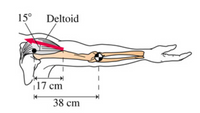
Concept explainers
If you hold your arm outstretched with your palm upward, the force to keep your arm from falling comes from your deltoid muscle. Assume that the arm with hand has mass 4.25 kg and the distances and angles shown. What force must the deltoid muscle provide to keep the arm in this position, in Newtons? Use g = 10.0 m/s2.
Your answer needs to have 3 significant figures, including the negative sign in your answer if needed. Do not include the positive sign if the answer is positive. No unit is needed in your answer, it is already given in the question statement.

Trending nowThis is a popular solution!
Step by stepSolved in 2 steps with 1 images

ok i understand much better now but where did the 0.258 come from (multiplied to 17)
how did you find F? im confused on where it came from
ok i understand much better now but where did the 0.258 come from (multiplied to 17)
how did you find F? im confused on where it came from
- A 12.2 m long board is supported from beneath at two locations. One is at the far left end of the board. The other is 1 m from the right end of the board. The board has a mass of 39.3 kg. What is the normal force (in newtons) applied by the right support?arrow_forwardDirections: Select the best answer for the following questions. Use g = 9.80 m/s? and assume all numbers are accurate to 3 significant figures unless otherwise indicated. 1. An 900 N billboard worker stands on a 3 m scaffold supported by vertical ropes at each end. If the scaffold weighs 400 N and the worker stands 1 m from one end, what is the tension in the two ropes that support the scaffold at either end?arrow_forwardA beam of length 11 m is supported as shown below. There is a pin in the bottom end of the beam and a mass hanging from the top end of the beam. If the mass of the beam is mb =264 kg, the hanging block has a mass of m1 =81.8 kg, theta = 50.1 degrees, and phi = 35.1 degrees, what is magnitude of the tension in the wire attaching the beam to the ground?arrow_forward
- A gymnast rises onto her toes, as shown in the picture on the right. The floor pushes up on the ball of her foot with a force of N=313 N. If 0=56.0°, what are FH the forces in her heel (TH) and ankle joint (T), and what is the angle o? Answers: TH=481 N; T,=761 N; b=20.7° N, 0. 4.25 cm 9.66 cm 5.arrow_forwardThe system shown in the figure is in equilibrium. If the block has a mass of 7 kg and the angle θ = 32. What is the tension in the string connecting the block to the wall? Express your answer in Newtons.arrow_forwardThe diagram shows a sign that wighs 50 N hanging from a uniform horizontal pole. The pole weighs 30 Newton's and it is 1.6 m long. Determine the tension in the supporting cable C and the magnitude and direction of the two component forces at the pivot, P, exert on the pole.arrow_forward
- Two children push on opposite sides of a door during play. Both push horizontally and perpendicular to the door. One child pushes with a force of 12.5 N at a distance of 0.750 m from the hinges, and the second child pushes at a distance of 0.550 m. What force must the second child exert to keep the door from moving? (assume friction is negligible)arrow_forwardTwo children push on opposite sides of a door during play. Both push horizontally and perpendicular to the door. One child pushes with a force of 185 N at a distance of 0.600 m from the hinges, and the second pushes at a distance of 0.400 m. What force (in N) must the second exert to keep the door from moving? Assume friction is negligible.arrow_forwardProblem 5: Fr Fm Bone -Muscle 100 30 cm W 4 cm 40 cm A simplified model of a human arm holding a weight is shown on the right. The length of the forearm is 40 cm and it has a mass of 1.7 kg. The bicep muscle is attached 4 cm in from the elbow joint and makes an angle of 73° with the forearm. The weight in the person's hand has a mass of 5 kg. a) What is the magnitude of the force provided by the bicep muscle needed to keep their arm at rest? b) What is the magnitude and direction of the force acting at the elbow (F;) in that same case?arrow_forward
 College PhysicsPhysicsISBN:9781305952300Author:Raymond A. Serway, Chris VuillePublisher:Cengage Learning
College PhysicsPhysicsISBN:9781305952300Author:Raymond A. Serway, Chris VuillePublisher:Cengage Learning University Physics (14th Edition)PhysicsISBN:9780133969290Author:Hugh D. Young, Roger A. FreedmanPublisher:PEARSON
University Physics (14th Edition)PhysicsISBN:9780133969290Author:Hugh D. Young, Roger A. FreedmanPublisher:PEARSON Introduction To Quantum MechanicsPhysicsISBN:9781107189638Author:Griffiths, David J., Schroeter, Darrell F.Publisher:Cambridge University Press
Introduction To Quantum MechanicsPhysicsISBN:9781107189638Author:Griffiths, David J., Schroeter, Darrell F.Publisher:Cambridge University Press Physics for Scientists and EngineersPhysicsISBN:9781337553278Author:Raymond A. Serway, John W. JewettPublisher:Cengage Learning
Physics for Scientists and EngineersPhysicsISBN:9781337553278Author:Raymond A. Serway, John W. JewettPublisher:Cengage Learning Lecture- Tutorials for Introductory AstronomyPhysicsISBN:9780321820464Author:Edward E. Prather, Tim P. Slater, Jeff P. Adams, Gina BrissendenPublisher:Addison-Wesley
Lecture- Tutorials for Introductory AstronomyPhysicsISBN:9780321820464Author:Edward E. Prather, Tim P. Slater, Jeff P. Adams, Gina BrissendenPublisher:Addison-Wesley College Physics: A Strategic Approach (4th Editio...PhysicsISBN:9780134609034Author:Randall D. Knight (Professor Emeritus), Brian Jones, Stuart FieldPublisher:PEARSON
College Physics: A Strategic Approach (4th Editio...PhysicsISBN:9780134609034Author:Randall D. Knight (Professor Emeritus), Brian Jones, Stuart FieldPublisher:PEARSON





